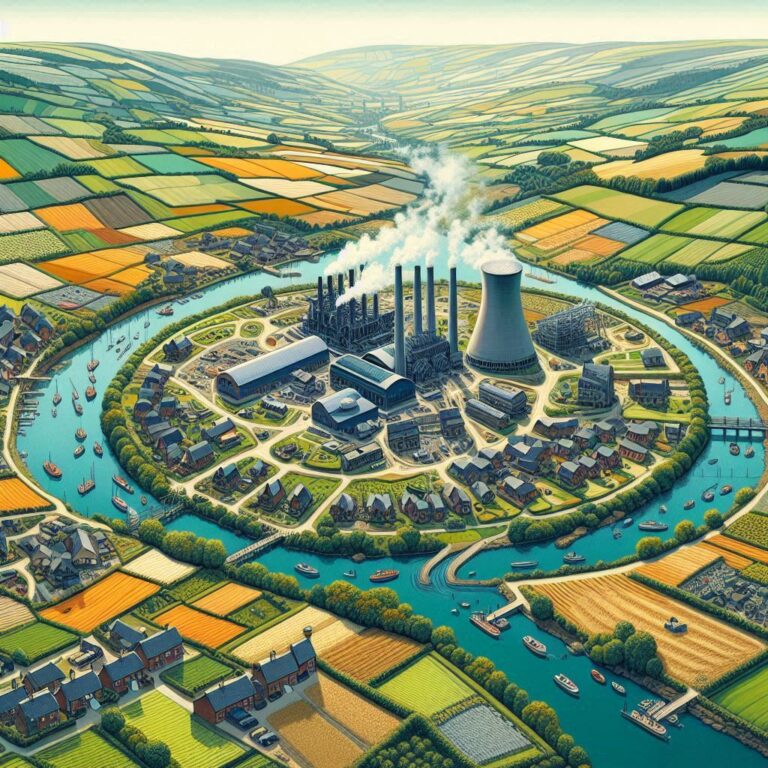What you need to know and be able to do:

What is a settlement?
A settlement is a place where people live. A settlement may be as small as a single house in a remote area or as a large as a mega city (a city with over 10 million residents).
A settlement may be permanent or temporary. However, a temporary settlement may become permanent over time. This has happened to many refugee camps that have been built in conflict zones or similarly favelas/shanty towns.
The reason a settlement was developed or built can be thought of as its function. This varies depending on the location of the settlement. Coastal towns tend to have the original function of being a port for trade, whilst other settlements can have religious, cultural or administrative functions.
Settlement site and situation
The piece of land upon which a settlement is built is the settlement site.
There are many reasons why a site might be chosen for the development of a settlement and some factors will be more important than others. How many features can you spot in the map of Southampton below?
Some common site factors include:
- Wet point sites – these have good water supply. Many settlements grew around wet point sites, e.g. Vicenza.
- Dry point sites – these are away from the risk of flooding, e.g. Bergamo.
- Defensive sites – often found on higher ground so that enemies could be seen from a distance, e.g. Monselice.
- Aspect – settlements are often found on the sunny side of a deep valley. This is common in settlements in the Alps.
- Shelter – from cold prevailing winds and rain.
- Resources – important for industry, e.g. villages such as Garraf, Barcelona are built to exploit a local resource.
- Bridging point – settlements with ‘ford’ in their name often grew around a fording point or bridging point, e.g. Bassano Del Grappa is built on the River Brenta.
- Trading centres – often settlements grow where natural route ways and rivers meet, which helps the development of roads, railways and canals. E.g. Padua, Bologna, Florence.
The importance of many of these functions diminish as technological advances enable people to overcome difficulties. Improved transport links, river management and trading partners all influence the function and location of settlements.
The situation of a settlement is its position in relation to the surrounding human and physical features, many of which will have an impact on the settlement’s type, size and function.
With modern settlements remember that decisions about location and situation have been made by planners, but that their priorities may differ from those that determined the location of a historical settlement like Cittadella. For example, a modern settlement does not need to be close to a river because drinking water is now piped to our homes and waterways are no longer important for transport.
Settlement functions
Most large settlements in MEDCs are multifunctional and perform a range of functions such as retail, education and industry. When settlements first started to grow, most had only one distinct function, and others developed as the settlement grew.
Examples of functions:
- Port – the original function of cities such as Liverpool and Southampton. Both are still ports, but this function has diminished in importance and they are now multifunctional.
- Market town – Watford was originally a market town, and although it still holds a regular market, it is now a thriving multifunctional centre.
- Resort – Southport was a popular Victorian seaside resort, although it now has many functions and is a commuter settlement for Liverpool.
- Natural resources in the area enabled Sheffield to develop as an important centre in the iron and steel industry. Although steel is still produced, its prominence has declined and Sheffield is a thriving multifunctional city.
Settlement hierarchies
If we group and classify a number of settlements according to their size and shape the result is settlement hierarchy

Pyramid showing relationship between population and services
As you move up the hierarchy, the size of the settlement and the distance between similar sized settlements increases. As you can see from the diagram below, there are more cities than conurbations, more towns than cities and more villages than towns.
The number of services that a settlement provides increases with settlement size.
Small settlements will only provide low order services such as a post offices, doctors and newsagents. Large towns, cities and conurbations will provide low and high order services such as leisure centres, chain stores and hospitals.
Larger settlements and conurbations have a much larger sphere of influence than smaller ones. This means they attract people from a wider area because of the facilities they offer. Cities such as London have a global sphere of influence, whereas a small hamlet or village may only have a sphere of influence of a couple of kilometres.
The range of a service or product is the maximum distance people are prepared to travel to purchase it. The range of a newspaper is much lower than an item of furniture for example.
Land use in MEDC’s
The Burgess and Hoyt model
The Burgess Model (Concentric Ring Model) is based on the idea that land values are highest in the centre of a town or city. This is because competition is high in the central parts of the settlement. This leads to high-rise, high-density buildings being found near the Central Business District, with low-density, sparse developments on the edge of the town or city

The Hoyt model
Central business district
The land in urban areas is used for many different purposes:
- Leisure and recreation may include open land, e.g. parks or built facilities such as sports centres
- Residential – the building of houses and flats.
- Transport – road and rail networks, stations and airports.
- Business and commerce – the building of offices, shops and banks.
- Industry – factories, warehouses and small production centres.
- The Central Business District (CBD) in the city centre is where most business and commerce is located.

The following features easily identify the CBD:
- High/multi-storey buildings.
- Expensive land values.
- Department stores or specialist shops, like jewellers.
- Shopping malls and pedestrian precincts.
- Cultural/historical buildings, museums and castles.
- Offices, finance, banks, administration, town hall (business sector).
- Bus and railway stations (transport centres).
- Multi-storey car parks.
The CBD is located in the centre because it is:
- A central location for road/railways to converge.
- The most accessible location for workers.
- Accessible to most people for shops and businesses.
To help you remember how to identify a CBD, think of a city you know. In your exam give named examples for the features listed above.
The inner city

Terraced houses
The inner city is also known as the ‘twilight zone’. It is typically found next to the CBD and has mainly terraced houses in a grid like pattern. These were originally built to house factory workers who worked in the inner city factories. Many of these factories have now closed down.
Unemployment and other socio-economic problems have led to periods of unrest in many inner city areas. Many inner city areas declined in the late 20th century and have undergone a period of regeneration in recent years. Run down terraced housing is often bought by investors and improved to appeal to young professionals who need access to the CBD. This is called gentrification.
The suburbs

Semi-detached
Suburban houses are usually larger than inner city terraces and most have a garden. Typically, they are detached or semi detached and the roads around them are arranged in cul-de-sacs and wide avenues. Land prices are generally cheaper than in the CBD and inner city, although the desirability of housing can make some areas expensive.
Facilities such as schools, places of worship and parks are often present, and many are served by a local supermarket.
Suburban areas are often home to commuters who need access to the CBD along main roads and railways, and they are also within easy reach of the countryside.
The urban rural fringe

Allotments in Ripon, North Yorkshire
This is found at the edge of a town or city and is where town meets country. It is common for this area to have a mixture of land uses such as some housing, golf courses, allotments, business parks and airports.
The mixture of land use often causes conflict as different groups have different need and interests. For example, building Terminal 5 at Heathrow on the outskirts of London was a source of controversy. The need for another runway continues to cause conflicts of interest.
Land use in LEDC’s
LEDCs have similar land-use needs to MEDCs, but the pattern of land use in urban areas is different.
Although every LEDC city has its own characteristics, models can be used to illustrate a ‘typical’ LEDC city.

Model of LEDC city
Both MEDC and LEDC cities have a CBD – often the oldest part of the city.
In LEDCs the poorest housing is found on the edge of the city – in contrast to MEDC cities whose suburban fringe is very often a place of high quality housing. The areas of poor quality housing found on the edge of cities in LEDCs are called squatter settlements or shanty towns.
Land use in Sao Paulo, Brazil
The below pictures show two very different areas of Sao Paulo in Brazil – the CBD and an outerlying shanty town.


Sao Paulo – the city centre
The CBD and high-class sector
The CBD in an LEDC looks very similar to a CBD in an MEDC. However, there is likely to be a more dramatic difference between the height of the buildings in the CBD and the height of the buildings in other zones.
The CBD contains facilities such as department stores, hotels, offices, schools, theatres and cinemas.
High-class housing can be found around the edge of the CBD and in a spine radiating out towards the edge of the urban area. This is likely to be a main transport route and a desirable street, possibly a former colonial area. People living here will need easy access to the CBD. Transport networks in LEDCs are not as well developed as MEDCs so the journey to work is a major consideration when deciding where to live.
The high class housing will be a mixture of old colonial houses and large apartments, both of which will have space for servants.
Shanty towns
The fact that cities in LEDCs are growing rapidly means that conditions can be poor. There are often great inequalities within LEDC urban areas and they are even more pronounced in LEDCs.
Some of the worst conditions are found in the shanty towns on the edge of the city, near the CBD or along main transport routes. They tend to be unplanned and are often illegal. Houses are self-built using basic materials and shanty towns have few services.
Shanty town residents face many problems on a daily basis. Khyalitsha in South Africa is a shanty town located near the city of Cape Town. Shanty towns are also known as townships in South Africa. Khyalitsha has a population of over 1.8 million people and is one of the largest townships in South Africa.

The Alexandra township in Johannesburg, South Africa
Problems:
- Overcrowding – the settlement has a high population density.
- Fires – fires can spread quickly.
- Overpopulation – the area does not have enough resources to support the growing population.
- Competition for jobs – jobs are in short supply.
- Disease – poor sanitation and limited health care can lead to the spread of disease.
- Lack of space – the newest and poorest arrivals may be forced to live on the worst quality land.
- Infrastructure – services are poor, public transport is limited and connections to the electricity supply can be limited and sometimes dangerous.
Improving shanty towns

Soweto township in Johannesburg, South Africa
Over time the conditions in shanty towns may improve. In many LEDCs, local communities, charities and government departments are working together to improve conditions in squatter settlements.
Improving conditions in a squatter settlements can lead to improvements in the residents’ quality of life.
Approaches to improvement

Urbanisation can cause problems such as transport congestion, lack of sufficient housing, over- rapid growth and environmental degradation. Many cities display particularly sharp inequalities in housing provision, health and employment. Some people try to escape these problems by moving away from the city – a process called counter-urbanisation. Long term, however, the solution must be to make cities more sustainable.
Causes of urbanisation
Urbanisation means an increase in the proportion of people living in urban areas compared to rural areas. An urban area is a built-up area such as a town or city. A rural area is an area of countryside.
As a country industrialises, the number of people living in urban areas tends to increase. The UK and many other MEDCs urbanised during the 18th and 19th centuries. People migrated from rural areas (due to the mechanisation in farming) to urban areas where there was employment in the new factories. The area of cities known as the inner city developed during this time as rows of terraced housing were built for workers.
On a global scale, urbanisation is taking place rapidly, particularly in LEDCs
Problems of urbanisation in the CBD – traffic congestion
As more people move to the edge of towns and cities, traffic congestion may get worse. Many people will drive their cars into the city centre to get to work.
It is compounded by people being brought into city on large roads or motorways. These roads then link up with smaller, older, narrower roads in the city centre. This causes a bottleneck and congestion.
Some cities have tried to manage this problem by introducing traffic management schemes.
These schemes may include:
- Park and ride schemes.
- Cycle lanes.
- Congestion charging schemes, such as those in London.
- Car-pooling, as used in the USA, to encourage people to share cars.
- Low Emission Zones, as in London.
- Encouraging the use of public transport
- Cheap bike hire
- Alternation of registration plates, like in Padua.
Local councils have also tried to make the roads in urban areas safer by introducing traffic calming measures, pedestrian zones, vehicle-exclusion zones and permit-only parking schemes.
Reducing congestion in cities
Park and Ride scheme operating in Plymouth

The introduction of Park and Ride schemes. People park in car parks on the edge of a settlement and catch regular buses into the centre.
Pedestrian shopping streets, Liverpool

Pedestrianised areas are designated as pedestrian only zones.
Permit holder parking in Westminster

Permit holder parking – certain parts of the city, particularly near the centre, are designated as permit parking only. This means that people must have a permit to park in that area. This reduces the number of people driving in to towns and cities as parking opportunities are restricted.
Vehicle exclusion sign

Vehicle exclusion zones – certain types of vehicles are excluded from certain parts of a city, eg large vehicles may not be allowed to enter narrow roads or residential areas.
Taxi cabs on a New York street

Car pooling – people are encouraged to share cars. This has been used in a lot in the USA.
Speed bump in a residential area in London

Traffic calming – roads narrowing and speed bumps make traffic move slower around narrower streets. Narrow roads may restrict the type of vehicle that can enter certain parts of the city.
Problems of urbanisation in the inner city – inequalities
Inequalities exist in all urban areas. Inequality means extreme differences between poverty and wealth, as well as in people’s well-being and access to things like jobs, housing, and education. Inequalities may occur in
- Housing provision
- Access to services
- Access to open land
- Safety and security
Often people who live in inner-city areas experience a poor quality of life. This is because the inner-city is typically a zone with older housing and declining industry.
Unemployment and incidents of long-term illness are higher in the inner-city boroughs, while households are more likely to have central heating and multiple cars in the outer-city borough.
Governments and planners often step in to help redevelop run-down inner-city areas. Inner-city redevelopments, such as those in London’s Docklands or El Ravel, may improve the physical environment of the area and improve the quality of housing. However, it can also create even greater inequalities because the local residents may not be able to afford to live there anymore. Often the old industrial jobs are replaced by skilled jobs and new people move to the area.
Problems of urbanisation in the urban rural fringe – housing demand

‘For Sale’ signs outside a house
As a result of increased urbanisation, Cities are spreading outwards. The demand for high quality, new, affordable homes in urban areas. As a result, land values are very high and land is in short supply:
Some developers are building on sites that have been built on before in the UK’s inner cities. These are called brown field sites. This has happened in many of the UK’s inner cities. Other developers are building homes on the edge of the city on green field sites in the urban rural fringe. Land here is cheaper but green field development can cause conflict with local people and create environmental problems.






